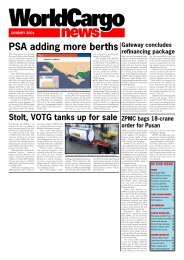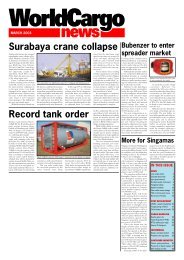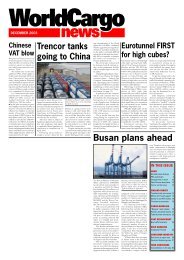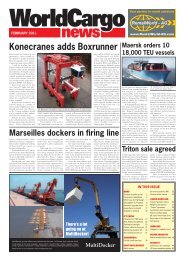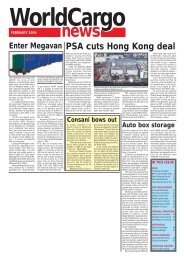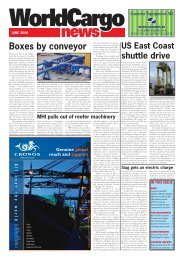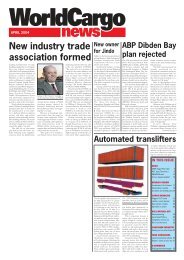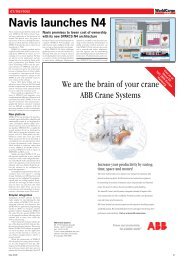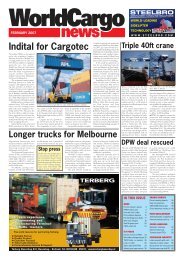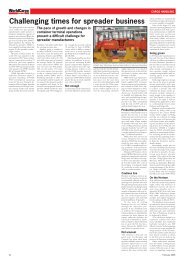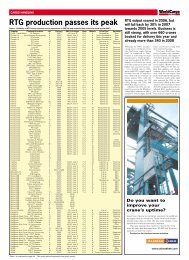US-built box crane - WorldCargo News Online
US-built box crane - WorldCargo News Online
US-built box crane - WorldCargo News Online
Create successful ePaper yourself
Turn your PDF publications into a flip-book with our unique Google optimized e-Paper software.
NORTH AMERICA: WEST COAST PORT DEVELOPMENT<br />
Congestion overcome...challenges ahead<br />
The congestion suffered by NAWC<br />
ports last year may have been a<br />
blessing in disguise as it spurred<br />
changes that have kept cargo moving this<br />
year, with few ports reporting traffic<br />
build-up, other than Vancouver BC,<br />
caught up in a truck strike through late<br />
summer. By mid-year <strong>US</strong>WC ports were<br />
handling 11 per cent more cargo than in<br />
the same period last year - a trend that<br />
has continued into early autumn.<br />
More labour has been the biggest help,<br />
with longshore gangs strengthened at<br />
major California gateways and in Puget<br />
Sound. Railroads have also pushed their<br />
crew hiring forward and added more<br />
motive power and rolling stock.<br />
In addition, off-peak traffic under<br />
Southern California’s PierPass programme<br />
begun in late July has surpassed expectations.<br />
In each of the first four nights of<br />
the more than 7500 containers entered<br />
or left Long Beach/Los Angeles marine<br />
terminals following normal closing hours,<br />
or almost 30 per cent of a typical day’s<br />
gate volume of 26,000 containers.<br />
The programme’s organisers originally<br />
set 30 per cent as a goal to be reached<br />
after two years running. To support the<br />
extra crews needed to operate five new<br />
evening shifts per week (Monday through<br />
Thursday between 18.00 and 03.00 and<br />
Saturday from 08.00 to 18.00), a traffic<br />
mitigation fee of <strong>US</strong>$40/TEU is levied<br />
on containers moved through the two<br />
ports during peak hours, Monday-Friday.<br />
RFID at GGS<br />
Shipping lines have also been hunting for<br />
ways to keep traffic moving. APL introduced<br />
active radio frequency identification<br />
(RFID) technology at its Global<br />
Gateway South (GGS) at Los Angeles the<br />
same day that PierPass was launched. By<br />
using real-time locating technology APL<br />
feels it will be able to reduce by as much<br />
as half a day or more the time it takes to<br />
track a container in the wheeled yard and<br />
prepare it for transport.<br />
RFID tags have been fitted to each<br />
chassis, transmitting location signals to<br />
computerised tracking equipment. Because<br />
nearly all containers at the GGS<br />
facility are on chassis, they can be spotted<br />
electronically and positioned for movement<br />
by truck, rail or ship. The technology<br />
has been available for years but, according<br />
to APL, the application represents<br />
its first-ever use at a <strong>US</strong>WC wheeled terminal<br />
and marks a milestone in its relationship<br />
with the ILWU.<br />
An agreement signed with the union<br />
in 2002 established guidelines for the<br />
implementation of waterfront automation<br />
and the use of RFID is seen as one of the<br />
first beneficial results. APL worked with<br />
the ILWU as well as with system designer,<br />
WhereNet Corporation, to develop and<br />
implement the technology.<br />
Scarce land<br />
Implementation of technology such as<br />
RFID and the spreading of truck gate<br />
operations over more hours of the day<br />
represent some of the areas of production<br />
enhancement left to major NAWC<br />
ports as land becomes scarce. In a stark<br />
shift from the last two decades there is<br />
only one new container terminal being<br />
<strong>built</strong> on the whole NAWC range, at<br />
Prince Rupert in northern BC, Canada.<br />
Three others remain on the drawing<br />
board: a new terminal at BC’s Roberts<br />
Bank requiring additional landfill; a potential<br />
terminal on Tacoma’s Blair Waterway<br />
using land under the control of a<br />
native American indian tribe; and Long<br />
Beach’s planned 160-acre Pier S complex,<br />
which still awaits the filing of an environmental<br />
impact report (EIR).<br />
The lack of new construction has<br />
showed up in Long Beach’s 2006 budget,<br />
which is <strong>US</strong>$40 mill less than the current<br />
year, primarily due to reductions in<br />
capital outlays. On the other hand,<br />
<strong>US</strong>$100 milll has been set aside for environmental<br />
programmes, marking a continuing<br />
trend at <strong>US</strong> ports where noise and<br />
air pollution control are at the forefront.<br />
This is expected to see ongoing development<br />
of shore-to-ship electrical<br />
power (“cold ironing”) as well as increased<br />
use of intermodal rail and more alternative-fuel<br />
cargo handling vehicles. Money<br />
is also to be invested in dust control and<br />
diesel emissions reduction equipment as<br />
well as improving road access through<br />
building new multi-level interchanges.<br />
Despite a lack of new construction,<br />
Long Beach is continuing third-phase<br />
completion of its Pier T container terminal,<br />
used by Hanjin, and carrying out<br />
improvements at Piers D, E and F, while<br />
container terminals on Pier A and G are<br />
slated for renovation. The port witnessed<br />
New ZPMC <strong>crane</strong>s being moved ashore from<br />
ZHEN HUA 1 at Cosco’s Long Beach terminal,<br />
operated for the port by SSA Marine<br />
<strong>WorldCargo</strong><br />
news<br />
a 24 per cent increase in its container traffic<br />
through the first half of the year and<br />
expects numbers to continue climbing.<br />
LA pays for delays<br />
Contrasting Long Beach’s growth expectations,<br />
but matching its budget cuts, the<br />
Port of Los Angeles is not looking for<br />
another TEU record this year. After predicting<br />
a six per cent growth rate in January<br />
it is now estimating that traffic will<br />
remain steady at about 7.3 mill TEU or<br />
roughly the same as last year.<br />
Its operating and capital budget, however,<br />
has been lowered by 10 per cent to<br />
<strong>US</strong>$418.7 mill, with port priorities now<br />
earmarked as “security, environment and<br />
community development.”<br />
Only two terminals are seeing signs<br />
of construction work, the China Ship-<br />
<br />
<br />
<br />
<br />
<br />
<br />
<br />
<br />
<br />
<br />
<br />
<br />
September 2005 25



